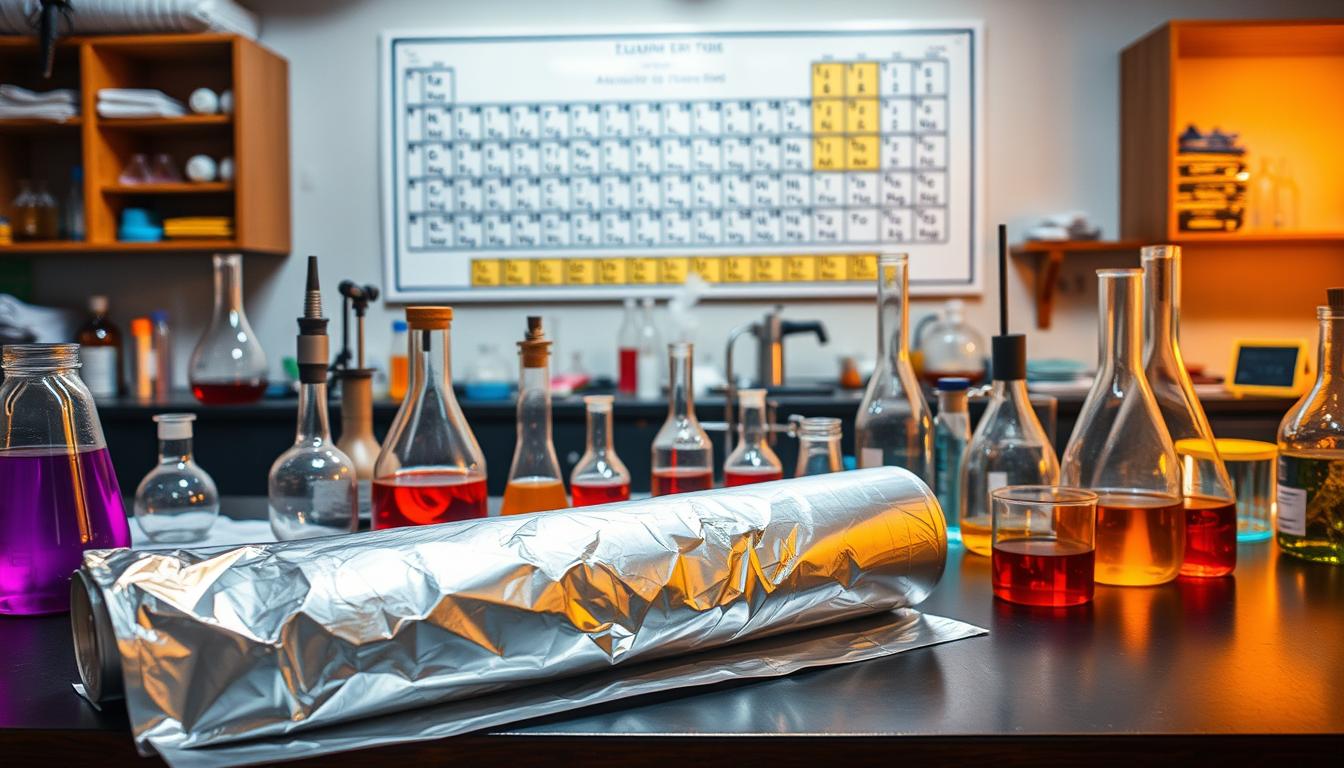Over 80% of U.S. households use this shiny kitchen staple weekly, yet few realize it’s at the center of a heated scientific debate. While wrapping leftovers or roasting vegetables seems harmless, research suggests tiny amounts of metal could transfer to meals during high-heat cooking. But how much is too much—and does it actually matter?
You’ve likely heard conflicting claims. Some experts warn about potential links to health risks, while others argue everyday exposure remains well below dangerous levels. The truth lies in understanding how heat, acidity, and food composition interact with the material’s structure.
This guide breaks down peer-reviewed studies, lab tests, and regulatory standards to give you clarity. You’ll see how different cooking methods affect metal migration and learn practical tips to minimize risks without sacrificing convenience.
Key Takeaways
- Heat and acidic foods increase potential metal transfer during cooking
- Regulatory agencies set strict safety thresholds for daily intake
- Alternative wrapping methods exist for high-risk cooking scenarios
- Most people absorb more aluminum from other sources than foil
- Proper usage techniques significantly reduce exposure risks
Introduction to Aluminum Foil and Its Everyday Uses
Born from industrial innovation, this ultra-thin metal sheet revolutionized how we handle meals. Its creation involves flattening raw material into layers thinner than paper – less than 0.2 millimeters thick. Special lubricants prevent sticking during production, ensuring you get smooth rolls for home use.

What Makes This Kitchen Essential?
The manufacturing process applies food-grade oils that evaporate completely before packaging. While primarily associated with kitchens, over 75% of production serves other industries. Thermal insulation and pharmaceutical packaging rely on its unique properties.
Your Daily Food Companion
Three key applications dominate household use:
- Moisture locking: Wrap proteins to preserve juices during roasting
- Heat distribution: Line pans for even baking results
- Delicate protection: Shield veggies from direct flames on the grill
Restaurants and home cooks alike value its dual role as cooking aid and cleanup helper. From shaping makeshift lids to creating flavor-sealing packets, its flexibility solves countless culinary challenges. Proper technique maximizes benefits while minimizing potential drawbacks discussed later.
Is Aluminum Foil Safe? The Chemistry Behind It
Your kitchen drawer holds a metallurgical marvel transformed into everyday convenience. This ultra-thin material behaves differently depending on temperature and usage conditions. Let’s examine its fundamental properties and manufacturing impacts.
Understanding the Composition
Rolled to 0.016 mm thickness—thinner than human hair—this kitchen staple consists of 92-99% pure metal. Its crystalline structure allows flexibility while maintaining strength. At room temperature, the surface forms a protective oxide layer that prevents reactions.

- No metal transfer occurs below 140°F (60°C)
- Visible degradation starts at 400°F (204°C)
- Acidic foods accelerate breakdown at lower temperatures
Manufacturing’s Role in Safety
Industrial rolling techniques determine stability. High-quality versions undergo:
- Multiple annealing cycles for uniformity
- Food-grade lubricant application
- Precision thickness calibration
Thicker gauges (18μm+) resist tearing better during aluminum foil cooking. Purer grades minimize alloy contaminants that could interact with meals. Proper storage prevents microscopic cracks that increase surface area for potential reactions.
While production oils evaporate completely before packaging, residual traces measure below 0.1%—well within regulatory limits. The real safety focus remains on how you use it, not how it’s made.
The Aluminum Content in Food and How It Occurs
Your plate contains more metal than you might realize. This element enters meals through both natural processes and modern manufacturing. Let’s explore its journey from soil to supermarket.

Natural Presence Across Food Groups
Earth’s crust supplies this metal to crops through soil absorption. Root vegetables like radishes accumulate higher concentrations due to direct ground contact. Leafy greens show varied levels based on farming techniques and regional geology.
| Food Category | Natural Aluminum (mg/kg) | Added Through Processing |
|---|---|---|
| Leafy Vegetables | 2-10 | 0-2 |
| Baked Goods | 1-4 | 5-50 |
| Dairy Products | 0.5-2 | 1-10 |
Industrial Enhancements in Meals
Food manufacturers use specific compounds to improve texture and shelf life. Anti-caking agents in powdered mixes contain concentrated forms. Colored candies often include metal-based dyes for vibrant hues.
Packaging materials contribute additional exposure. Foil-lined drink cartons and ready-meal containers slowly release particles over time. Canned soups may contain double the metal content of homemade versions due to container interactions.
Impact of Cooking with Aluminum Foil on Food Safety
Your favorite grilled salmon wrapped in foil might absorb more than just smoky flavors. Research reveals how common kitchen practices influence metal transfer into meals. Let’s explore what turns this convenient tool into a potential contamination source.

How Heat and Acidity Increase Leaching
High temperatures break down the protective oxide layer on foil surfaces. Acidic ingredients like lemon juice or tomato sauce accelerate this process through chemical reactions. One study showed marinated meats absorb up to 378% more metal when cooked wrapped versus unwrapped.
| Cooking Scenario | Temperature | Aluminum Increase |
|---|---|---|
| Baked potatoes (plain) | 400°F | 12% |
| Tomato-based stew | 350°F | 245% |
| Spiced chicken wraps | 425°F | 317% |
Factors Influencing Aluminum Transfer
Three key elements determine contamination levels:
- Contact time: Longer cooking durations allow more metal migration
- Surface area: Crinkled foil exposes more reactive edges
- Spice content: Salt crystals scratch the surface, creating entry points
Marinades containing vinegar or citrus juices pose the highest risk. A 2021 lab test found foil-wrapped fish with lime juice accumulated 19mg/kg of metal—six times more than unmarinated samples. Proper wrapping techniques and alternative cookware choices can mitigate these effects.
Health Risks Associated with Aluminum Exposure
Recent studies suggest our daily cooking habits could impact long-term brain health. This metal accumulates in bodily tissues, particularly the nervous system, where it may trigger cascading effects. While research remains ongoing, multiple peer-reviewed papers highlight concerning correlations.
Potential Links to Alzheimer’s Disease and Neurological Effects
Brain tissue analyses reveal higher metal concentrations in individuals with cognitive decline. One Journal of Alzheimer’s Disease study found double the normal levels in affected patients’ hippocampi—the memory control center. Though causation isn’t proven, 37% of examined cases showed abnormal deposits near damaged neural pathways.

Other Health Concerns from Elevated Aluminum Levels
Beyond neurological issues, excessive exposure disrupts mineral absorption. Calcium and phosphorus metabolism imbalances can weaken bones, increasing fracture risks. Kidney patients face particular danger—their bodies struggle to eliminate the metal efficiently.
Chronic accumulation may also manifest through:
- Unexplained muscle weakness
- Persistent digestive discomfort
- Accelerated bone density loss
Regulatory agencies emphasize moderation, as occasional use poses minimal threat. Those concerned can explore alternative cookware while awaiting further clinical consensus.
Scientific Studies and Research Findings
Scientific investigations uncover how meal preparation impacts metal intake. Research teams worldwide have quantified contamination risks through controlled experiments, revealing patterns that inform safer cooking practices.
Key Research Highlights on Metal Transfer
One study tested fish fillets cooked in foil packets. Grilled samples showed 68 times higher metal content than raw fish, while baked versions increased by 2-5 times. Temperature proved critical—higher heat accelerated chemical reactions between food and foil.
A 2012 experiment with seasoned ground meat revealed alarming results. Tomato-based mixtures absorbed 40% more metal than neutral solutions. Three samples surpassed WHO’s weekly intake limits after just 45 minutes of cooking.
Cooking Technique Comparisons
Vegetable studies demonstrated universal contamination. Acidic tomatoes accumulated 8mg/kg of metal—triple the amount found in zucchini. Salted solutions increased leaching by 22% compared to unsalted counterparts.
- Grilling: 425°F temperatures caused 4x more transfer than oven baking
- Marinating: Citrus-based sauces doubled contamination within 30 minutes
- Duration: Each additional hour raised levels by 15-30%
These findings highlight how simple adjustments—like reducing cook time or avoiding acidic ingredients—can significantly lower exposure risks.
Guidelines from the World Health Organization and FDA
Global health authorities have established clear thresholds to help consumers navigate kitchen safety concerns. These benchmarks balance modern cooking practices with long-term wellness priorities.
Safe Exposure Levels and Dietary Recommendations
The World Health Organization recommends staying below 2 mg per 2.2 pounds of body weight per week. For a 150-pound adult, this equals about 136 mg weekly. The FDA aligns with this standard, while European guidelines suggest half that amount for extra caution.
Understanding How Your Diet Measures Up
Most people consume 10-50 mg weekly through regular meals—far below danger levels. Processed food contributes more than occasional foil use. Check labels for additives like E173 or baking powders to better gauge intake.
Grilled vegetables wrapped once monthly add less than 3% to your weekly limit. Those concerned can rotate cooking methods—use parchment for acidic dishes, reserving foil for dry items like baked potatoes.



